Dhaka to Sylhet Division and back Thur 17 - Sun 27 June 2010
So once more we headed away from Dhaka - before we go special thanks have to go to Mr. Mahmudur Rahman of Navana Toyota - who helped us get our air conditioning blasting away better than ever and gave Andrew a private place to work on the fridge, on which he changed the new part (thanks again to Engel) but still no joy - looks like we may need a new engine - there's always something!

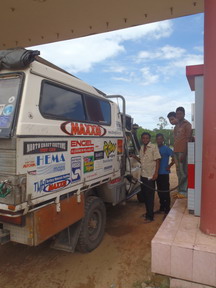
Anyway refreshingly cool we wove our way through the traffic to our next destination of Sonargaon. Sonargoaon - or Golden City in Hindi - was once the capital of Bangladesh pre-dating the Muslim invasion and reaching its heyday in the 13th century - though very little remains from these days. It continued to prosper under the Muslims until the Mughal rulers finally moved the capital to Dhaka in 1608. We intended to stop off quickly on our way north - but we timed the Dhaka traffic wrong - so it took us over 3 hours to drive the 23km out there. That's what comes of being in a city with a population of 60 million people!! It was a surprisingly tranquil area and felt a million miles from Dhaka more like a little country village.
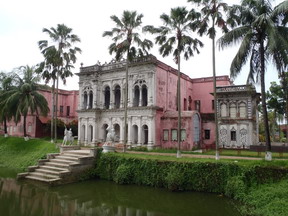

First stop was the Sadarbari Folk Art Museum - housed in a really lovely rajbari (palace) dating from 1901. Inside was a jumble of historical artifacts and handicrafts - which we were lead around by a guide. A lot of evidence of the Hindu past of the area - images of Ganesh, Krishna and other Hindu deities - some beautifully carved from teak. The displays are split between the old building and a new very flash purpose built building. The gardens are a delight - trees plants and ponds - full of a variety of bird life - we saw some vibrantly coloured Kingfishers.
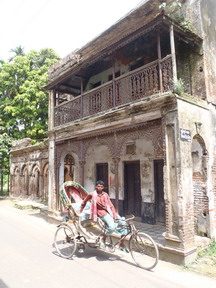
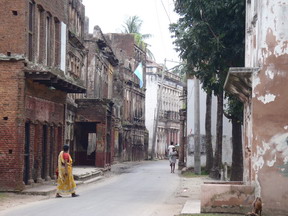
We had met a student Dubai up in Gaud Rajshahi and he had kept in touch with us by phone throughout our trip and he and a friend came out to Sonargaon to show us around which was very kind. After the museum we then headed on to the main area of historical interest - the small town of Painam Nagar. This elegant town was once the home of wealthy Hindu merchants and was constructed in the late 19th and early 20th centuries. After partition most of the Hindu rulers fled and since then (with the remaining Hindus leaving in the 1960s due to the anti -Hindu riots) the once beautiful homes have sadly continued to rot away. Now nature is really starting to take over but as you walk down the narrow streets you do still get a feel of the area's former glory. Some of the houses are inhabited but none of them have been kept up to a good level which is a shame.
 | 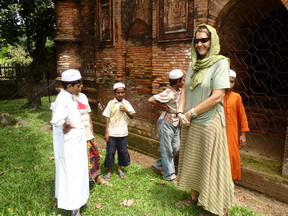 |
A bit behind schedule we drove on to Syhlet - and arrived at our first destination the small town of Srimingal just after dark. As we drove the last few kms we passed through Finlays one of the main tea estates where the workers were all packing up and walking home and we could really smell the tea from the packaging area of the factory.
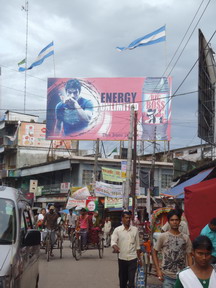
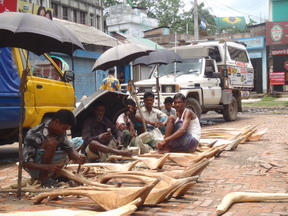
We got to town and took a modest little room at the Hotel United right in the town centre - fairly basic but a snip at 300 BDT or $5 a night. Srimangal is a small town set picturesquely amid hills (a first for us in this country!) fruit orchards and numerous tea estates and very attractive it is too. Tea was first introduced to the region in 1854 by the British. About 170 estates remain - only half are still British owned the rest being owned by wealthy Bangladeshis or the government. The British brought tea workers from India rather than training locals, and most of these were from Bihar, Orissa and West Bengal - the present day workers are all descendent of these people and have largely remained Hindu though some have been converted to Christianity.


After our big drive of the day before we spent a day taking it easy and having a wonder around Srimangel. It was a vibrant little town and the people were very friendly. We quickly noticed that far more English is spoken here. The Sylhet division is where the majority of the British migrants hail from and there is a bit of a UK connection here. World cup fever abounds still and whilst the green and gold and blue and white of Brazil/Argentina still dominate you do see a few more of the red crosses around. We are still flying ours from our aerial! Whenever you see a huge crowd in the streets it usually means there is a football match on and a good proportion of the town is crowded around one TV. Not a good time to try and get a rickshaw - particularly if one of the South American favourites is playing!
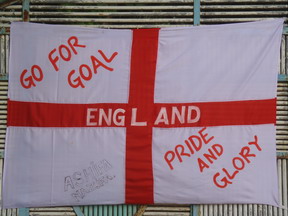
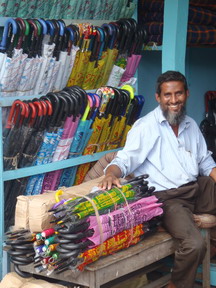
There have definitely been more tourists here - as the begging was pretty bad. Once out of the hotel we were inundated - largely by kids - showing their bellies saying they were hungry and demanding Mangoes. One little boy was particularly strident and would literally wrap his arms and legs around you and screech "ahm ahm ahm ahm ahm ahm " ahm being Bangla for mango.

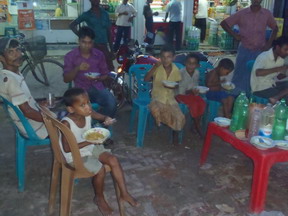
There was a little store near where we parked the car which sold hot meals for 10 BDT and we treated our gaggle of followers a few times. A lot of them did look like they could do with a few square meals.


Appropriately for the wet season there was also a thriving umbrella store and the usual jumble of food fruit (LOTS of mangoes also good fresh pineapples) veggies and tailors shops all jumbled together. We also saw some different stores one selling homemade fish traps and craftsmen in the town square making handmade plough heads from hard wood.
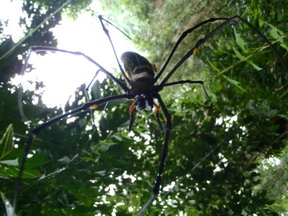
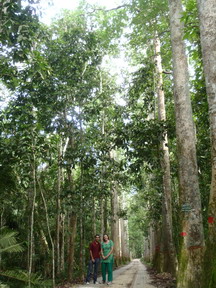
We were keen to have a look around the various local attractions - the tea plantations, the nearby Lowacherra NP and tribal villages- and as you need a guide at least for the latter 2, we decided to book a tour with a guy called Russell from Community Eco-Tourism. So at 7am the next morning a bit bleary eyed (especially Andrew who had stayed up to watch the Brazil game the night before which didn't start until 12.30 am here!) we picked up Russell and drove out the 7 km to the Lowacherra NP.
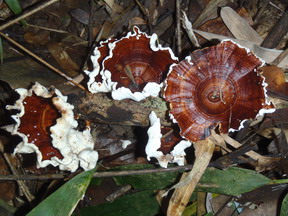
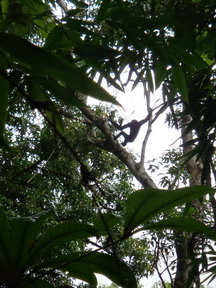
Lowacherra NP measures 1250- hectares and is part of a larger (2740 hectares) protected reserve and had a real tropical jungle feel, hot and sticky with lush green vegetation huge insects and a background soundtrack of birds and animals. The highlight of the park is the endangered hoolock gibbon. Russell was determined that we see some and took us off the track from where we trekked deep into the jungle. We heard the gibbon's territorial cry and hurried after them (through thick forest very slippery) and we were lucky enough to witness 3 males as they crashed through the trees.
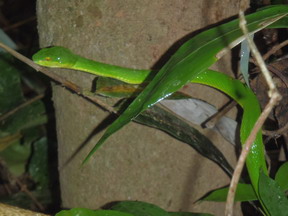
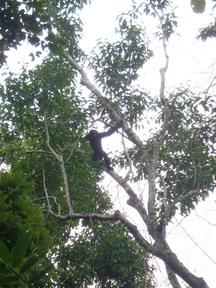
One actually turned and watched us for a while. There was a female (they are a lighter colour) a little way away Russell heard from her call but we never saw her- it was amazing to see these rare animals in the wild. We also had another very close encounter when Russell spotted a (very poisonous) green tree snake. Andrew had just stepped over it without seeing it - so no doubt it would have gone for me (trailing behind the other 2 a bit!) if Russell hadn't spotted it - it blended in really well. It was actually very beautiful though a bit scary. We also heard barking deer, and numerous birds (246 species live here) and saw some huge orb spiders. We also saw some striking fungi and some leeches close up!! There is a railway through the middle of the park -perhaps not ideal for the animals but a very scenic trip no doubt- and we all sat on the tracks for some leech removal from inside our shoes! We really felt we'd had a good jungle experience and would really recommend Russell's services. His number to follow.


So - dripping wet and muddy we drove on to our next stop the Zareen Tea Estate. Though Bangladesh is a major tea producing area (55 million kg per annum) there is no exploitation of the tourist potential of this - no commercial tours of the tea making process with a complimentary cuppa to follow - and certainly no cream tea like in the Cameron Highlands in Malaysia which would have been a nice touch!! Though it is tough getting in to see the tea making process and requires all sorts of permissions which are hard to come by - they seemed happy enough for us to stop and watch ladies hard at work picking tea. It really is a lovely scenic area and we came across an artist at work depicting the rolling hills covered in tea bushes. As I mentioned the tea workers are mainly Hindu still and small shrines like the one in my picture are dotted around the estate.
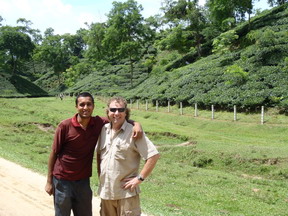
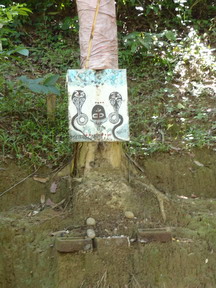
Russell had another pre-arranged client arriving so we dropped him back in town and picked up our new guide (arranged by Russell) Hiron.
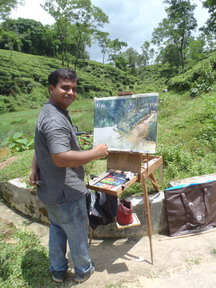
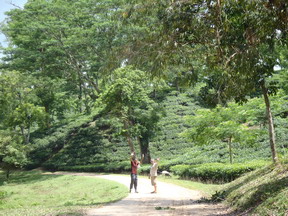
Taking up the tour where Russell left off Hiron took us to visit one of the native villages of the indigenous Tripura people - this was in fact Hiron's home village as he belongs to this tribal group.
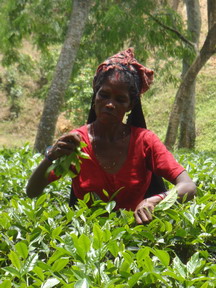


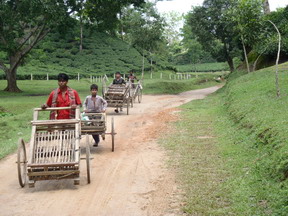
This village was called Doluchara and the people here were largely Christian (no doubt the converters got in here!) and there was a little Christian church and a weaving room. Much of the village was deserted when we went - apparently they'd all gone to a wedding at another village so it was like a ghost town.
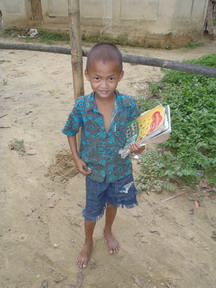

The kids have a little local school and we caught them on their way home. Many of the villagers (like Hiron) have jobs in town but some farm - mainly limes and pineapples - or make their living from spinning cloth.
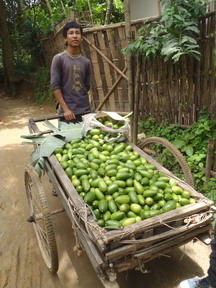

We next headed to the Madhabpur Lake - set within one of the tea gardens this was a very scenic spot with a walk around a gorgeous lake covered all over with water lilies - Bangladesh's national flower.
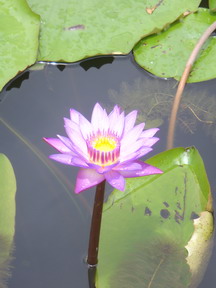
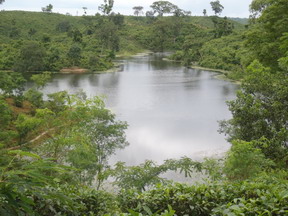
After this it was back to Srimangal for a quick lunch before heading to visit another tribal village this time a Khashia one. The Khashia people are also Christian (well these ones were anyway) - some Catholic some Protestant - and live in settlements within the rainforest. Their hilltop villages are invariably surrounded by betel-nut trees -they harvest the leaves and nuts which are used for chewing.
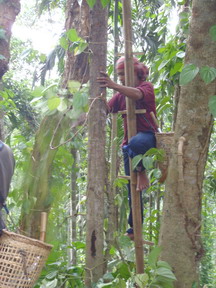

It is a very hands on concern with everyone in the village getting involved - the young men climb up the trees on scary looking ladders, they cut down the branches which the older men (and the kids) then strip off the vines and pass them on to the girls and women who sort them into bunches - one bunch has 144 leaves - and they' re then sold in town. Presently production is very high and one bunch goes for around 30 BDT - in the dry season when production slows as the trees don't produce so much it goes up to 300-400 BDT.

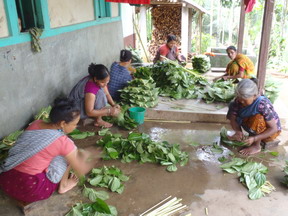
We were introduced to a family who were very friendly and gave us tea and a betel nut to chew. I wasn't keen on the latter, but I gave it a go to be polite - they didn't add the lime which causes the reaction which turns your saliva bright red thankfully!!

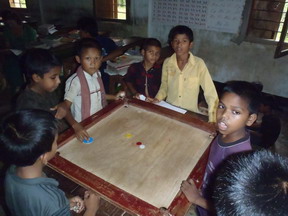
There was a school for Bangladeshi (i.e.) non Khashi) kids too - who are part of the Christian minority from very poor families so they live here to get an education. They were playing board games and football when we visited - again football fever reigns supreme!!
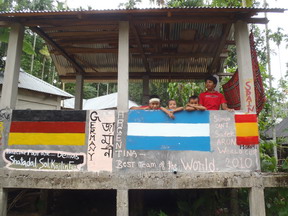
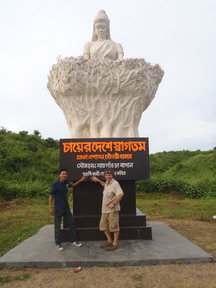
To round off our tour we went to the Nilkantha Tea Cabin - just out of town this tea room specializes in producing a "world famous" 5 colour tea - actually it does a 7 layer one too - but we stuck with the 5. It has apparently been drunk by all manner of famous local personages according to the pictures on the walls and it was interesting - you could taste 5 distinct flavours as you drunk through the layers. We really enjoyed the tour and would recommend both Russell and Hiron as guides- Russell can be contacted on 01718604347 or russelbd09@gmail.com and Hiron on 01734461614 and devhirok@gmail.com
 |  |
So next day off we headed leaving Srimangel to head on the back roads to Sylhet, the capital city of the division of this name via the Madhabkunda waterfall. As we left town we headed past a road gang of men and women hand -making tar roads. Very hot smoky work!
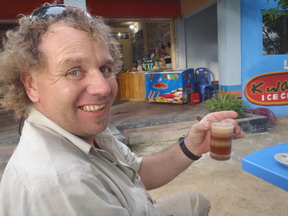
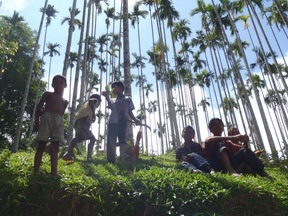
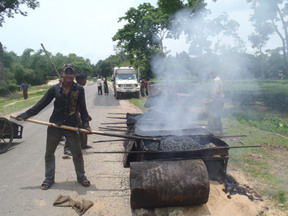
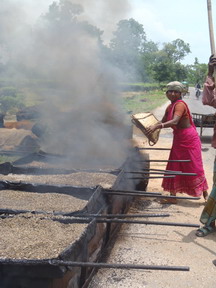
It was a scenic drive through rural Sylhet - we went past a village where men were making traditional wooden boats which was very interesting for Andrew, and past many of the Chinese style fishing nets -very similar to the ones found in Kochi India.
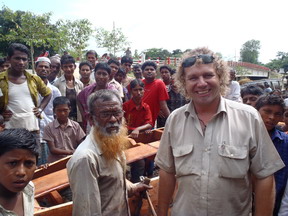
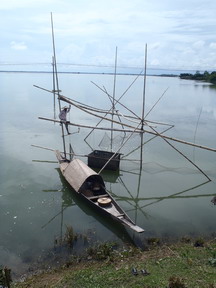
The scenery was unbelievably green and no wonder - there was plenty of rain! This was the first we'd really seen of the famous Bangladeshi floods - many of the roads were completely underwater. Life was going on around this - houses were accessible only by boat, the cattle were either half submerged in water or clinging to the banks at the edge of the fields and everyone was going about their business waist deep in water! I think it's just a way of life once a year out here!!


Incredibly on the way to the waterfall we went through 15 or so water crossings! The Madhabkunda waterfall is a major tourist attraction and there were a few coach loads of Bangladeshis there when we arrived.

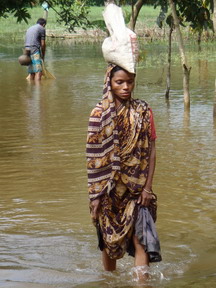
It was good weather for waterfalls and it was a fairly impressive sight - though we've seen a few on our trip to date! The local policeman insisted on accompanying us all the way down and back up- and kept asking us if we had any problems for some reason! We also got several hundred people taking our pictures, which is always a bit tiring so after a look we were ready to head on - especially as we weren't sure how much more flooding we'd have to cross on our way to Sylhet and it was getting dark.

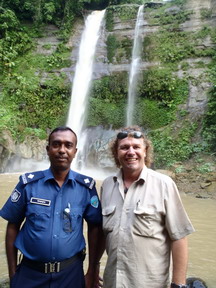
Sylhet is a pretty busy city not a good contender for camping and we quickly found a cheap hotel the Hotel East End. Sylhet is where most of the British Bangladeshis hail from and UK type names (LFC- or London Fried Chicken, The Britannia Brasserie etc ) abound. It was a nice little hotel and very friendly and we negotiated a 3 night deal at a good rate - but subsequently found out the bed was the most uncomfortable ever! Never mind we survived -albeit with the odd sore back!

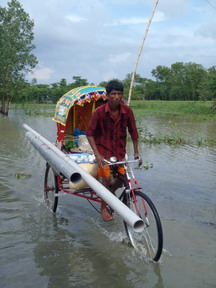
Sylhet is quite a prosperous city - all that ex-pat attention - and very friendly. For once our England flag had company - lots of England supporters here - and lots of interest in us and our trip. Everyone had relatives from the UK - mostly in Birmingham or East London - and they were all up for a chat. We went for a drive around and crossed over the Kean Bridge. This bridge was damaged by the Pakistani army during the war and has since been repaired. It was full of rickshaws and we drove over it though we later found out it's only for cyclos and auto-rickshaws -no wonder we got some funny looks!
So off we went to explore Sylhet - first we went to the Osmani Museum which was fairly low key - so much so that no one had heard of it! General Osmani was a key figure in the liberation war and much of his planning apparently took place in this pleasant colonial house. He made up for his lack of height (5 ft and a ½ inch) by having an incredibly impressive moustache! It was a funny display - containing just exhibits as "Chair the General sat in" …"Crockery in which the General's meals were served." All very fascinating! Sorry we didn't get any pictures of this riveting stuff for some reason.

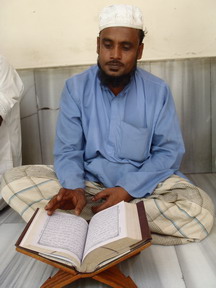
Next we headed to the main centre of pilgrimage in Sylhet - the Shrine of Hazrat Shah Jalal. This shrine around the tomb of this 14th century Sufi or Muslim Saint is a huge place of pilgrimage for Muslims from all over the world. When we arrived we weren't quite sure where to go so we were very lucky to meet Zaffar. He is responsible for security at the shrine and speaks excellent English so he very kindly showed us around. The Sufi originally came by foot from Saudi Arabia. His robes and sword still exist and are kept in the mosque though not on public display. We had a look around the grounds - it is considered a great honor to be buried here and there is a sizeable graveyard. The courtyard was full of pilgrims and many beggars - some very disabled and they can be a bit overpowering particularly when they spotted us. Zaffar told us that the shrine authorities here provide them with free meals which we were pleased about. In our LP it talked of sacred catfish in the pond which were supposed to be Hindu magicians under a spell, I asked Zaffar about this and he said it was nonsense…..oh well! Apparently the REAL story is that once some poor fishermen brought the saint a gift of fish and those in the lake are their direct descendants. We joined the line feeding them.
Women aren't allowed up to the tomb where Shah Jalal and his male relatives/disciples lie but Andrew went up - after duly washing his feet - and reported back with pictures. At the top (he says) were many Islamic scholars studying the Quran.


Zaffar kindly invited us back to his house for afternoon tea and to visit the nearby Laakatoorah Tea Estate just nearby. His home was beautiful - with high ceilings and a lovely garden. It was apparently a complete rebuild as the original was destroyed by the Pakistan army when they took it over in the 1971 war. At this time Zaffar and his family all had to flee over the nearby border into India, thankfully unlike many Bangladeshis they survived to tell the tale.

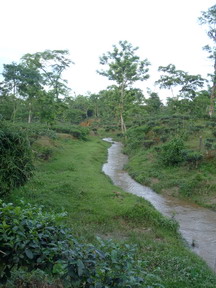
The Laakatoorah Tea Estate was very scenic - we went for a walk around it as the sun set - followed by some local kids. We then visited the nearby Basti or village where the tea workers live. They make a bit of extra income by making a home brew which they sell and we had a glass and it wasn't unpleasant - a clear liquid very like vodka. The tea workers were lovely friendly people and very hospitable, as were Zaffar and his brother Moni who runs a car repair business from the house. Moni went out of his way to help Andrew getting some welding repairs done on the car and refused any payment for doing so. Thanks very much to both Zaffar and Moni for all their help and kindness to us.
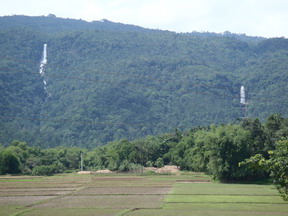

The next day we took a drive out to the nearby Tamabil Indian border just 55km to the north. There isn't a huge amount there but we'd heard that the scenery was lovely and it was - all green fields, rolling blue hills and waterfalls - many of them actually across the border in India. Whilst you can cross here the border is mainly used to import coal from India and piles of coal and trucks can be seen everywhere.

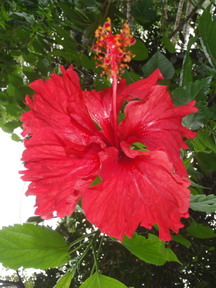
Just near the border is the town of Jaflang, nearby which are several more tea estates, as well as numerous tribal areas - mainly Khashia people growing their betel nut trees.

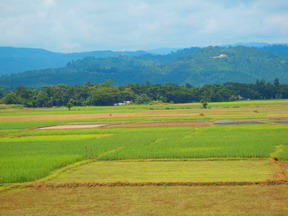
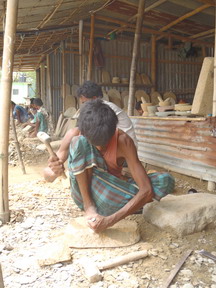

This area is unique in Bangladesh as it is where stones are mined. The river Mari here is where numerous boulders from the Himalayas in India are deposited. These stones are dug out of the river and transported by trucks to nearby quarries where they are broken down to make gravel for concrete. All looked like very hard work! Nearby numerous craftsmen work on the stones making headstones for graves, implements for grinding rice and tourist keepsakes. It really was some of the most stunning country we've seen in Bangladesh actually a bit like Laos - funny to see hills again!
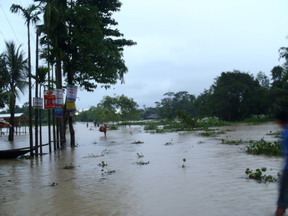
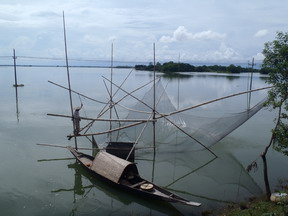
Next morning, Friday 25 June we drove the 5 hours back to Dhaka once more. As we drove in we passed numerous garment and knitwear centres - Bangladesh is number 1 in this field and allegedly many big companies are moving their operations from China to here due to quality control issues with the former. Sadly there is allegedly a lot of child labour in that sector here - some of it in pretty grotty conditions so they don't really encourage a spotlight on this. We're back to Dhaka once more as we have a meeting with Mobil one of our sponsors on Monday and again we plan to try and finalize our ongoing visa extension matter - we've now been travelling visa-less for more than a month though no one seems to be that concerned!
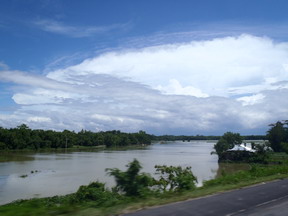

Definitely Dhaka is one of the worst areas to date for begging. Whenever we pull up at traffic lights we are swarmed - severely disabled people on trolleys propel themselves forward precariously through the traffic to tap on your window and beg, and tiny kids - some literally toddlers- climb on the car asking for money, seeing how they live it's amazing how cheerful a lot of them seem to be really. There are also vendors (again mainly kids) selling all sorts of stuff popcorn, drinks, and flowers and of course FIFA contender flags. One little salesman said he'd give me a good deal on an Argentinean flag to replace my English one as England hadn't a hope of winning!!
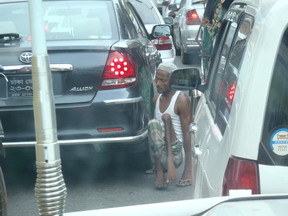
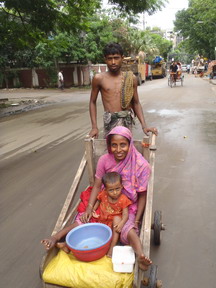
The 25th is a very important date - Andrew's birthday! - so after we spent most of it driving through the floods we finally hit Dhaka (back to our usual homestay in Banani) and went out for dinner to celebrate. When we arrived in Banani for the first time we had walked into "Doo Wick" a Korean restaurant and just as quickly turned around and walked out again as it was way too pricey for us! Now in honour of Andrew's birthday we were back and ordered a real special treat meal - sushi, Korean pancakes (like tempura) and 2 steaks which were cooked on the table in front of us. It was all absolutely delicious. As a further real treat we had had some beer. Bangladesh is a Muslim country but alcohol isn't totally banned - and is apparently often available at these more pricey places frequented by foreigners- we just don't usually go to them!! Anyway it was a great night - and one of the best meals we've had "on the road" - it cost $73 Aus which is way more than our budget - but it's not often. Next time is my birthday in December - not sure where we'll be then!

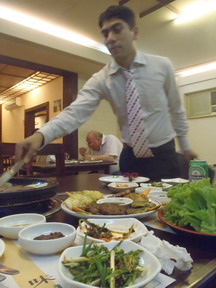
As I type on Sunday the 27 June we had been planning to go to the Immigration Office and sort out our visa extensions today. However on the way we realized that everything seemed to be shut - and we discovered that there is a hartal or strike going on to protest about increases in the cost of rice and milk. As these can get a bit violent if you get caught up in the wrong place we have been advised not to do much today so we're hanging out and doing the website. Tomorrow we head to our meeting with all at Mobil - more of that to follow -and after that we head on towards the Chittagong Division home to some of Bangladeshi's highest and most beautiful scenery. In the meantime good luck England for the big match tonight! We'll be cheering you on.
